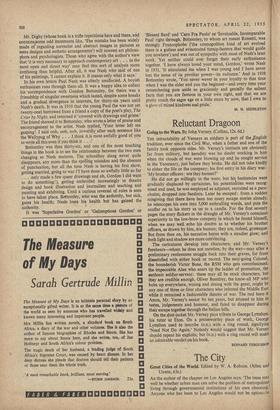Meaning and Symbol in Three Modern Artists. By George Wingfield
Digby. (Faber and Faber, 30s.)
literary purpose, nor yet in its :esthetic qualities, but in the
sYmbolic images of its hidden depths. For his purpose he has chosen—rather arbitrarily, it may be thought—three artists for examination: Edvard Munch, Paul Nash and Henry Moore. The
links between the two Englishmen are clear (in particular their Preoccupation with what Nash called 'object-personages outside
the plan of natural phenomena' ! ), but with them Munch has little In common other than that he too attempted to express certain apprehensions of a highly subjective kind. These three, Mr. Digby takes in turn, and examines them in the light of Jungian Psychology.
Munch's melancholic, at times psychotic, art is not very hard to understand. Mr. Digby establishes him as introverted and of
'11111g's feeling-intuitive type (as indeed most northern expres- sionists have been); he further relates a number of Munch's paint- togs to particular inner tensions arising from the artist's childhood
't,,od various crises of later life. Henry Moore's dismemberment of
Mr. Digby (whose book is a trifle repetitious here and there, and contains some odd statements like, The mistake has been widely made of regarding surrealist and abstract images in pictures as mere designs and esthetic arrangements') will interest art philoso- phers and psychologists. Those who agree with the author's view that 'it is very necessary to approach contemporary art . . . in the most open and direct way' may find this sort of analysis more confusing than helpful. After all, it was Nash who said of one of his paintings, 'I cannot explain it. It means only what it says.'
In his own letters Paul Nash was utterly unaffected. A boyish enthusiasm runs through them all. It was a happy idea to collect his correspondence with Gordon Bottomley, for theirs was a friendship of singular sweetness which lasted, despite some breaks and a gradual divergence in interests, for thirty-six years until Nash's death. It was in 1910 that the young Paul (he was not yet twenty-one) borrowed from a friend a copy of the poet's play, The Crier by Night, and returned it 'covered with drawings and grime.' The friend showed it to Bottomley, who wrote a letter of praise and encouragement to the artist. Nash replied, 'Your letter left me gasping! I said oob, oob, oob, inwardly after each sentence like the Wallypug of Why . . . I think it is most awfully good of you to write all this even if you think it . .
Bottomley was then thirty-six, and one of the most touching things in the book is to see the relationship between the two men changing as Nash matures. The schoolboy slang never quite disappears, any more than the spelling mistakes and the absence of punctuation, but all the time Nash is having his first show, getting married, going to war ('I have done so awfully little so far . . . only made a few queer drawings and oh, Gordon I did want to do something!), getting embroiled increasingly in theatre design and book illustration and journalism and teaching and painting and exhibiting. Until a curious reversal of roles is seen to have taken place. Bottomley, who was the authority, but sick, gains his health; Nash loses his health but has gained the authority.
It was 'Superlative Gordon' or 'Galumptious Gordon' or 'Blessed Bard' and 'Caro Fra Paolo' or 'Invaluable, Incomparable Paul' right through. Bottomley, to whom art meant Rossetti, was strongly Francophobe ('the cosmopolitan kind of art evolved there is a gutless and eviscerated turnip-lantern that would guide you nowhere') and was out of sympathy with most of Nash's later work. Yet neither could ever forget their early enthusiasms together. 'I have always loved your mind, Gordon,' wrote Nash in 1931. 'It stimulated me when I was young and I have never lost the sense of its peculiar power—its radiance.' And in 1938 Bottomley wrote, 'You never waver in your loyalty to that time when I was the elder and you the beginner—and every time your remembering puts aside so graciously and genially the salient facts that you are famous in your own right, and that we are pretty much the same age or a little more by now, that I own to a glow of mixed kindness and pride.'











































 Previous page
Previous page